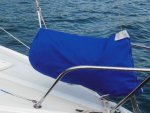Yellow Ballad
Well-known member
A silly question showing my inexperience but I've only ever sailed yachts before with roller reefing genoas but Sundance has hank on head sails. Last year was mainly day sails so it was only a case of picking the size hanking on and hoisting as soon as we were off the mooring and when dropped using sail ties to hold the sail between the two guard wires (like in the pic). But this year I'm planning some longer trips and may like to keep a smaller sail on deck or be able to lash the bigger sail down rather then stick it down the hatch in a sea.

As you can see the toe rail is smooth so I can't lace down to that at the moment but I've bought some eye bolts to replace the odd deck bolt every foot or so for maybe 6 ft back so I'm able to be able to rig something better, but what? These should give me something to use for the spinnaker pole/lash the dinghy if needs be, they should be far enough forward not to catch sheets as well hopefully.
Anyone got any old school pics of what they did? Zig zag between stanchion bases outside the lines over the top down to the toe rail? Something else? As I say I feel a little bit silly asking, I feel like this is something I should know already.
Many thanks in advance.
Tom

As you can see the toe rail is smooth so I can't lace down to that at the moment but I've bought some eye bolts to replace the odd deck bolt every foot or so for maybe 6 ft back so I'm able to be able to rig something better, but what? These should give me something to use for the spinnaker pole/lash the dinghy if needs be, they should be far enough forward not to catch sheets as well hopefully.
Anyone got any old school pics of what they did? Zig zag between stanchion bases outside the lines over the top down to the toe rail? Something else? As I say I feel a little bit silly asking, I feel like this is something I should know already.
Many thanks in advance.
Tom
Last edited:



